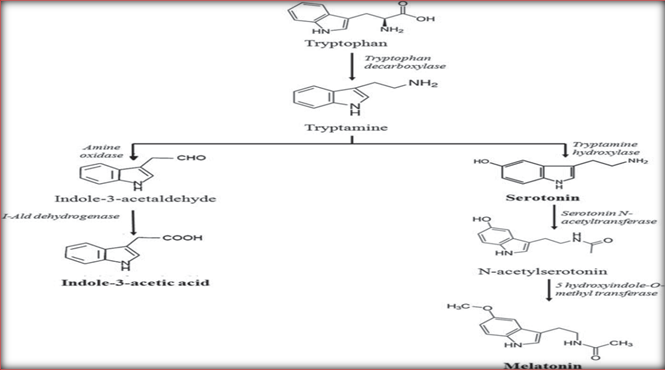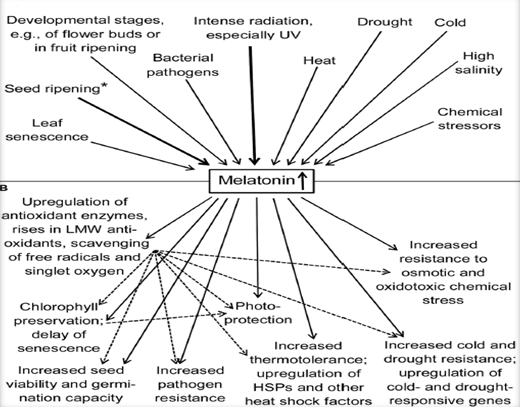फाईटोमैलाटोनिन: पौधों में जैविक तथा अजैविक तनाव प्रबंधन के लिए पौधा हार्मोन
The science behind plants stress tolerance to biotic and abiotic stresses always remained interesting and important to enhance the crop productivity in arid and semiarid regions all over the world. Today different stresses arise due to climate change, as well as due to natural and man made activities.
Melatonin, once discovered in vertebrates as a hormone of the pineal gland, is now known to be formed in bacteria and numerous taxa of eukaryotes including various algae of different phylogenetic position and plants.
It is biochemically N-acetyl-5-methoxytryptamine; biogenic indoleamine, structurally related to tryptophan, tryptamine, serotonin and indole-3-acetic acid (IAA). This hormone is involved in physiological activities.
Plants accumulate high levels of melatonin when faced with harsh environments (Arnao and Ruiz, 2015; Zhang et al., 2014) and exogenously applied melatonin helps to improve tolerance to stresses. Melatonin ubiquitously present in organisms whose metabolism based on oxygen, so speculated that its primary function to protect organisms against oxygen toxicity.
Melatonin in plants has been detected by several methods including radio Immuno Assay (RIA), enzyme-linked immunosorbent assay (ELISA), gas chromatography-mass spectrometry (GS-MS), and high-performance liquid chromatography (HPLC) with electrochemical detection (HPLC-ECD), fluorescence detection (HPLC-FD), or HPLC-MS (Nawaz et al., 2016).
Phytmelatonin synthesis
Phytomelatonin synthesized from tryptophan with the help of tryptophan decarboxylase, tryptophan hydroxylase, tryptamine 5-hydroxylase, serotonin N-acetyltransferase, N-acetylserotonin methyltransferase, caffeic acid O-methyltransferase enzymes in different subcellular locations (fig.1).
- Tryptophan decarboxylase (TDC) is first committed enzyme for melatonin biosynthesis in plants, catalyzes tryptophan into tryptamine or 5-hydroxytryptophan to serotonin. It is soluble cytosolic protein exists as a homodimer with a monomer molecular weight of 54,000. It shows high substrate specificity to tryptophan and 5-hydroxytryptophan
- Second step in melatonin biosynthesis is catalyzed by Tryptophan 5-hydroxylase (T5H) and is associated with the hydroxylation reaction, which is predominantly mediated by cytochrome P450-dependent monooxygenases (P450s) and 2-oxoglutarate-dependent dioxygenases (2-ODDs) in plants. It also catalyse Tryptophan to 5-Hydroxytryptophan and N-Acetyl tryptamine to N- Acetyl Serotonin reactions.
- The penultimate step in melatonin biosynthesis is catalyzed by serotonin N-acetyltransferase SNAT (also known as arylalkylamine N-acetyltransferase, AANAT). It catalyzes transfer of an acetyl group from acetylcoenzyme A to an array of molecules, such as aminoglycosides and arylalkylamines. The rice SNAT enzyme can accept various amine substrates, such as serotonin, tryptamine, and 5-methoxytryptamine, which are catalyzed to N-acetylserotonin, N-acetyltryptamine, and melatonin.
- 5-hydroxyindol O-methyltranseferase is last step enzyme; it catalyzes N-acetylserotonin into melatonin by O-methyltransferase (OMT) reaction.

Source: Kaur et al., 2015
Fig.1 Biosynthesis of melatonin in plants
Mode of action of Phytomelatonin
Melatonin has greater antioxidative potential. Melatonin molecule consists of an electron-rich indole moiety and 2 side chain groups: 5-methoxy group and 3-amide group (Fig. 2). The high resonance stability, electroreactivity and low activation energy barriers make melatonin a potent free radical scavenger.
The side chains also have a significant contribution in the antioxidative properties of the molecule. Carbonyl moiety present in the functional group (N-C=O) of C3 amide side chain has a key role in the quenching of more than one reactive oxygen species.
After the interaction of melatonin with ROS, the nitrogen present in the carbonyl group of the melatonin molecule leads to the formation of a new 5 membered ring (Kaur et al., 2015)
It is an endogenous free radical scavenger and a broad-spectrum antioxidant. It detoxifies a variety of free radicals and reactive oxygen species (ROS) including hydroxyl radical (OH•), peroxy nitrite anion (NO3-), singlet oxygen (1O2• -) and nitric oxide (NO•).
One of the most appealing properties of this molecule, which distinguishes it from most antioxidants, is the fact that its metabolites also have the ability to scavenge ROS and reactive nitrogen species (RNS).
Melatonin generates free radical scavenging cascade providing continuous cell defense, even at low concentrations with highly effective protection from oxidative stress.
Although melatonin acts as a direct antioxidant it may also regulate activities of several antioxidant enzymes including superoxide dismutase (SOD), catalase (CAT), ascorbate peroxidase (APX), glutathione peroxidase (GSH-PX), glutathione reductase (GSSG-R).

Source: Kaur et al., 2015
Fig. 2 ROS quenching sites of melatonin
Melatonin has proven to be ubiquitously synthesized in plant organs. Both abiotic and biotic stresses have been shown to induce melatonin synthesis in plants. The compensatory rise in melatonin under stressful conditions, in turn, helps to alleviate the negative consequences of stress, in particular oxidative stress, in the plants.
Typically, stress of any type to plants compromises their growth which is often secondary to excessive generation of reactive oxygen species (ROS) including free radicals. Pleiotropic roles ranging from enhancing germination to delaying senescence of plants have been reported.
- Delay senescence
- Promote growth
- Stimulate photosynthetic activity
- Protect plant against different types of abiotic and biotic stresses
- Participate in processes that affect plant development and reproduction
- Stabilize membrane
- Up and down regulate gene expression during different environmental conditions
- Enhances the phytoremediative capacity of plants
Conclusions
Melatonin is a remarkably, heterogeneously-functioning beneficial molecule in plants. Its discovery in land plants two decades ago has led to a burgeoning investigative field that has already made substantial advances in uncovering the marked actions of this versatile indoleamine.
References:
- Arnao MB and Ruiz JH. 2015. Functions of melatonin in plants: a review. J. Pineal Res. 59:133–150.
- Kaur H, Mukherjee S, Baluska F and Bhatla SC (2015). Regulatory roles of serotonin and melatonin in abiotic stress tolerance in plants. Plant Signaling & Behavior 10:11- e1049788.
- Nawaz MA, Huang Y, Bie Z, Ahmed W, Reiter RJ, Niu M and Hameed S. 2016. Melatonin: Current Status and Future Perspectives in Plant Science. Front. Plant Sci. 6:1230.
- Zhang H, Zhang N, Yang RC, Wang L, Sun Q, Li DB, Cao Y, Weeda S, Zhao B, Ren S and Guo YD. 2014. Melatonin promotes seed germination under high salinity by regulating antioxidant systems, ABA and GA4 interaction in cucumber (Cucumis sativus L.) J. Pineal Res. 57:269–279.
Authors:
Dhole, H. N. Shelat, D. G. Panpatte and Y. K. Jhala
Department of Agricultural Microbiology,
B. A. College of Agriculture, Anand Agricultural University, Anand (Gujarat)
*Email of corresponding author:

